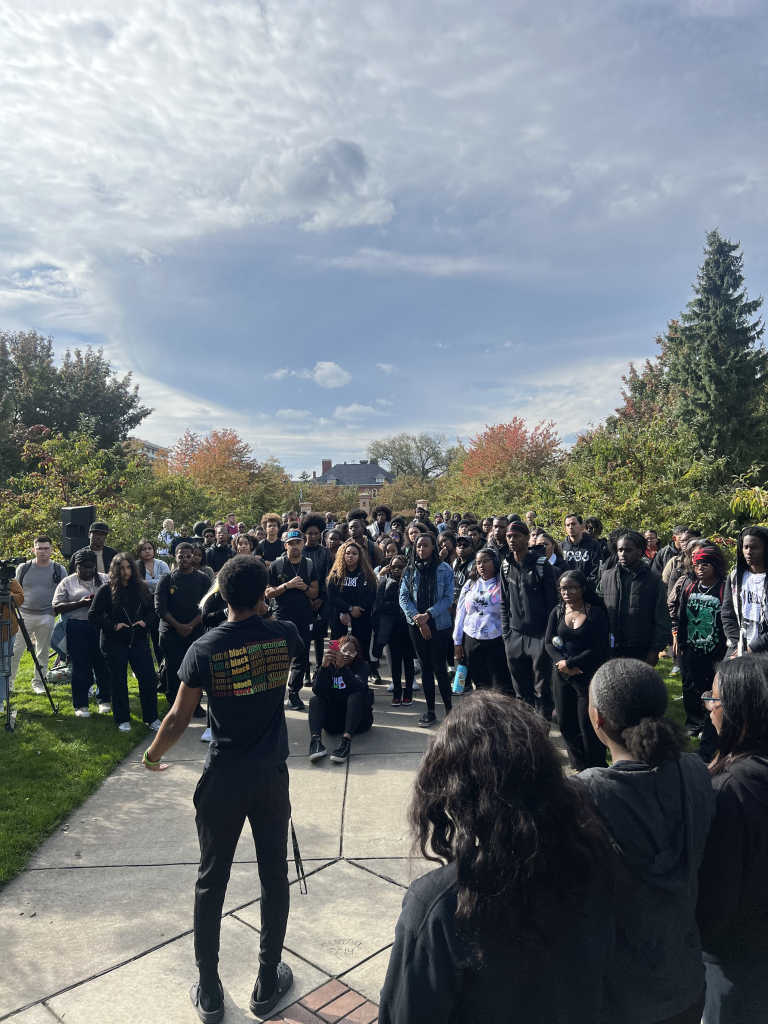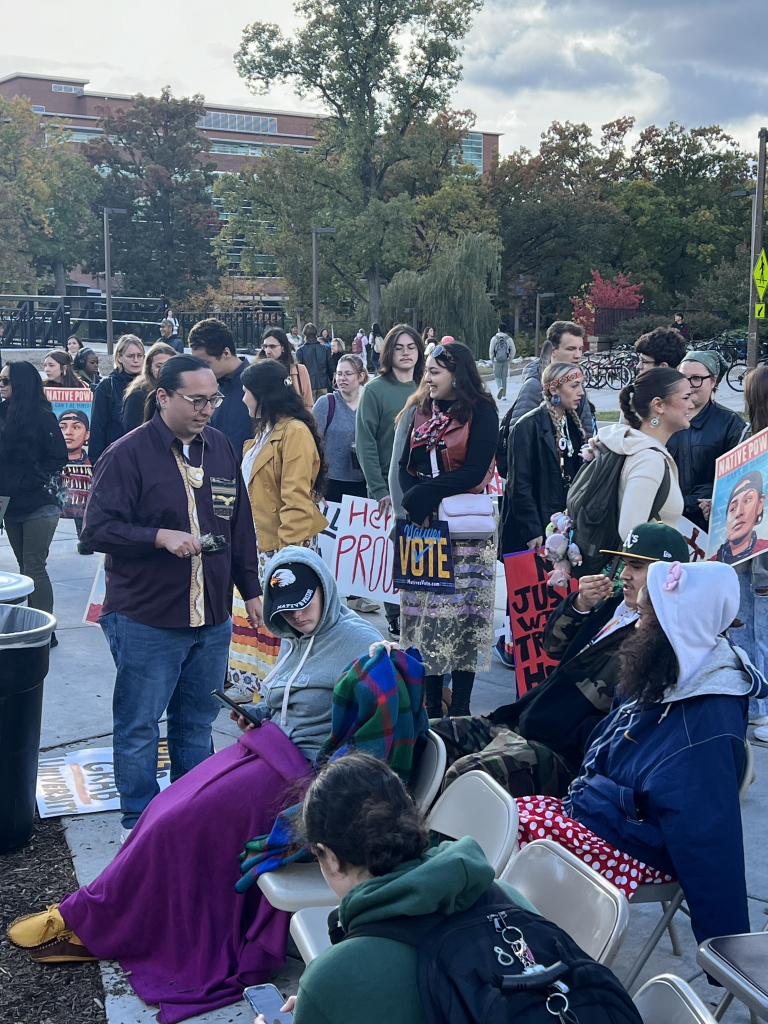

OUR MSU (2012)
In 1969, the concerns of Black students came to a head with the University administration. Black students believed racism and discrimination pervaded the University and they had strong feelings about the lack of sensitivity for Black students’ problems, the lack of Black student and faculty involvement in University affairs and the low number of Black faculty and staff employed at the University. Essentially, most Black students viewed the University as a monolithic, closed, White power structure that offered few opportunities for participation in governance, decision-making and employment.
[Read more about “BSA holds Wilson cafeteria; claims harassment of blacks”]
One particular area of concern to Black students and student affairs staff was the lack of Black advisory staff in student service positions. In the fall of 1968, and winter of 1969, the student affairs staff met with Black students to specifically discuss ways of increasing minority staff in housing positions. A proposal for a Black student Aide program was developed by the director of Residence Hall Programs and approved by the group. Dr. Milton Dickerson, Vice President for Student Affairs, approved funding for 24 Black student Aides in the spring of 1969. As a result of the program’s growth, the Coordinated Minority Student Programs Office (CMSPO) was created from which the Aide program was coordinated and implemented. In 1972, the program was expanded to include Chicano/Latino and Native American students and its name was changed to the Minority Aide Program. In the spring of 1987, Vice President for Student Affairs and Services, Dr. Moses Turner, expanded the Minority Aide Program to include the Asian Pacific American student population. Implementation of the APA Aides began in the fall of 1987.
In May 1989, Black student leaders on campus held a “Study-In,” taking over the John Hannah Administration building for ten (10) days, as a demonstration of a peaceful protest to the University’s lack of response or attention to racial ethnic student concerns and issues. Several of the students who participated in this Study In, were Aides, from all the various racial ethnic student communities. After several days of negotiations, the Black student leaders who served as the spokespersons, Darius Peyton, Ray Hearn, and Jeffrey Robinson, were successful in getting MSU administrators to address several long-held concerns that Black students had endured for several years, which included: increased number of Black faculty and staff, increased services and programs targeted at Black student retention, and the changing of CMSPO’s name to the Office of Minority Student Affairs. Also as one of the Black students’ demands, they advocated for requiring that the administration hold similar discussions with each of the three other racial ethnic student communities: Asian Pacific American students, Chicano/Latino students, and Native American students.
Michigan State University 1989 Study In excerpt
Made with Windows Live Movie Maker (http://download.live.com/).Posted by Darius Peyton on Wednesday, October 16, 2013
In the Spring of 1993, Assistant Provost, Dr. Lee June, worked with Chicano/Latino, Asian Pacific American and Native American faculty/staff and students to further expand the number of Minority Aides of those respective communities. In the fall of 1993, the program expanded to include 55 Minority Aides. In the fall of 1995, two additional positions were added for a total of 57 Minority Aides. In the winter of 1999, two APA Aides and two Black Aides were added to the program for a total of 61 Minority Aides.
In July of 2001, the Office of Minority Student Affairs was renamed the Office of Racial Ethnic Student Affairs (ORESA) to more accurately reflect the mission of the office and the need for clarity regarding students served. Aides were renamed Racial Ethnic Student Aides in the 2001-2002 year. In December 2006, the office name was changed to the Office of Cultural & Academic Transitions (OCAT). Aides were later renamed Intercultural Aides in the 2011-1012 academic school year.
The Intercultural Aide Program was established as one aspect of the administration’s commitment to making Michigan State University a more positive and hospitable environment for students of color. The overriding purpose of the program is to provide assistance to students of color needing help with social adjustment and academic survival and to provide a communication linkage between students of color, residence hall personnel and other student service offices.
In addition to assisting individuals with social adjustment, academic concerns and cultural connections, a major commitment of the Intercultural Aide Program staff is to help students in planning cultural, social and academic programs. This is accomplished by assigning student staff in the residence halls (Intercultural Aides) who act as resource agents for students and staff. It is the Aide’s duty to: 1) be aware of the activities and climate in his/her hall and to approach students as individuals; 2) articulate the feelings and concerns of students in the halls on relevant social, cultural and academic issues; 3) help students identify and utilize the resources of the University, and, most importantly; 4) develop a sensitivity regarding the problems encountered by students trying to make a successful transition to residence hall life and the University environment.
Because people from all walks of life are assigned to live together in residence halls, Intercultural Aides have the opportunity to facilitate a total living/learning experience for everyone involved. All students can learn more about the multicultural and ethnic society in which we live, thus becoming more aware of and sensitive to the cultures, concerns and life experiences of other people.
Chronological History of the Office of Cultural & Academic Transitions and the Intercultural Aide Program:
Sept 1969: Black Student Aide Program established under Dept of Residence Life
1973: Native American Cultural Room opens in Hubbard Hall
Sept 1974: Chicano Aides added into the Program, Centro de la Raza opened in Wilson Hall
Sept 1975: Chicano/Latino Student Coordinator full-time position established within office, coordinator is also responsible for Native American student outreach & programming
Sept 1975: Native Aides added into the Program
Sept 1986: Four (4) Complex Coordinator positions created within the program
Sept 1987: Four (4) Asian Pacific American Aides added into the Program; APA Heritage Room opened in Holden Hall: APA Student Coordinator full-time position established within office. [APASO’s 25th Anniversary Celebration & Reunion Timeline]
Dec 1988: Native American Student Coordinator full-time position established within office.
May 1989: Black Student Study-In occurs at the Administration Building; Black students, several who are Aides, occupy building for a total of 10 days until University administration agrees to meet to negotiate demands.
Sept 1989: Coordinated Minority Student Programs Office (CMSPO) changes name to Office of Minority Student Affairs (OMSA) as a result of the Black Student Study-In. As one of study-in demands, Aide program is to be evaluated every two (2) years in order to insure appropriate and adequate ratio between Aide and student residents.
Aug 1993: As result of Asian American/Chicano-Latino Coalition advocacy, two (2) more APA Aides and two (2) more Latino Aides are added to the program.
Aug 1996: Two more African American Aides and two APA Aides are added to the program.
Aug 1998: Two more APA Aides added to the program in order to ensure the approximate Aide to student ratio of 1:50.
July 2001: Office of Minority Student Affairs name changed to Office of Racial Ethnic Student Affairs (ORESA). Minority Aides renamed Racial Ethnic Student Aides in the 2001-2002 year.
Aug 2004: Aide outreach efforts change to have Aides serve not only students who share Aide’s particular racial/ethnic background, but to all students of color within the Aide’s assigned jurisdiction (floors, hall or set of halls). The organizational structure of Aides also changes to have ten (10) Team Coordinators instead of only 4 Complex Coordinators, allowing for a more effective smaller “team orientation” and allowing for more Aides to gain increased leadership experience in an elevated Aide position.
Dec 2006: Name of the office, Office of Racial Ethnic Student Affairs, is changed to the Office of Cultural & Academic Transitions (OCAT). Racial Ethnic Student Aides are renamed Transition & Cultural Aides.
Aug 2007: Aide outreach efforts expand even more, becoming even more inclusive to include students of color, international students, and new freshmen students in the residence halls.
August 2009: Currently, there are sixty-seven (67) Aides, with ten (10) of these positions as Team Coordinator. The Aide central staff is composed of OCAT non-student staff members called Area Coordinators, fluctuating from 3 to 5 ACs each year.
History of Black Caucus Rooms & Cultural Rooms in the Residence Halls:
The national sentiment during the mid-1960’s related to needed improvements in civil rights for Black Americans, caused MSU to examine its posture on the recruitment and retention of Black students. It was determined that a special effort, beyond what was currently taking place, was necessary to insure that the University’s student population was diverse and representative of the many communities it served. As a result, the “Detroit Project” was instituted, bringing many more Black students to the campus than had ever been here before.
As larger numbers of Black students enrolled at MSU in the late 1960’s, it became evident that more comprehensive efforts were needed to retain these students and to insure their academic success. The problems these students were experiencing indicted that the “traditional” approach used for all students was not sufficient.
One of the major points of difficulty for Black students was in their residential environment. As minorities, these students often experienced feelings of isolation, loneliness and alienation that frequently obscured their academic and career goals. Overt racist acts directed at them were additional obstacles to their success.
Ervin Armstrong presented the idea of Black Culture rooms in order to help Black students establish their own cultural niche in Michigan State’s environment, a predominately White institution. The culture rooms were to be the center of his proposal to formulate a base of Black Culture on the MSU Campus. He had an idea that Black students, in their struggle for survival in the early era of MSU’s Black student recruitment thrust, needed something to identify with at the University that would not be transient. They needed something that all Black students, both then and those of the future, would be able to look at, draw encouragement from, and make additions to with their own impressions of the culture. The students realized that special programs, grant in aid, remedial and counseling programs would rise and fall with the administrative whims. The establishment of the Black Culture room was their answer to “working within the system,” to become part of it by finding their place in it.
History gives evidence to the either inherent or created differences between White and Black cultures, which stands now for the reason why the culture rooms were proposed to serve as a room for Black students’ self-expression. One culture room was founded in each hall, with the planning and cooperation of then Residence Life Director Gary North, Carl Taylor and financial support through Robert Underwood, then manager of Residence Halls, along with student input and involvement. The first Black Culture Room, located in Shaw Hall, was established in September 1969.
In 1987, APA students were given space in the basement of Holden Hall, which they named the Asian Pacific American Heritage Room. Starting with little more than a few chairs and a couple of tables from storage, APA students used this room for various student organization meetings, especially the Asian Pacific American Student Organization (APASO). In spring 2008, the APA Heritage Room was changed to the Vincent Chin Memorial Room.
A Native American Heritage Room was established in the basement of Hubbard Hall and the Centro de la Raza, now known as the CRU room was created in the basement of Wilson Hall.
Currently, there are 19 caucus rooms throughout the residence hall system. They were initially used for and continue to be used as: libraries, places for social and academic activities, and as performing arts meeting places. Since the 1980’s, these caucus rooms are still used by African American students residing in the halls to conduct caucus meetings, hold small-scale programs, and serve as a place where students can study. Improvements, renovations, and efforts to beautify and maintain these rooms continue to be a challenge to meet as little financial support for these efforts is there.
(text comes from the 2006-2007 Transition & Cultural Aide Manual with an update in reference to the Vincent Chin Memorial Room)
